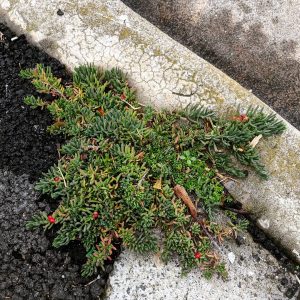Ruby Saltbush (Enchylaena tomentosa), a native perennial groundcover growing as a pavement weed in outer Northcote.
Ruby Saltbush is a drought and salt-tolerant, mat-forming groundcover which is widely distributed across dryland and coastal Australia. It is also found north and west of Melbourne and in coastal areas along the Mornington and Bellarine Peninsulas. However, the seemingly late date of collections in the Port Phillip region (from 1904, whereas it was collected from the Murray in the 1850s) and the disjunct nature of this population should perhaps raise a little doubt as to whether the species was present in this part of the state prior to the colonial period.
Nevertheless the plant is included in the official benchmarks for a number of Victorian Volcanic Plain vegetation communities (on rocky clay / duplex salty soils, rock escarpments, and grassy creeklines), it is available from local indigenous nurseries, and it has been widely planted in recent decades. The adaptability, tolerance for drought and disturbance, and capable weed suppression of Ruby Saltbush have made this species a frequent selection in revegetation plantings over other more temperamental small groundcovers. Frequent adoption in council planting treatments, and the general availability of hot, difficult soils, kerbed planters and areas of pavement in Melbourne’s dryland suburbs have also surely enhanced the distribution of this tolerant survivor.
Spread by ingestion by birds and other animals, we can see from this occurrence that, as with the Nodding Saltbush (Einadia nutans), Ruby Saltbush is quite capable of growing as a pavement weed in Melbourne where some protection from traffic is available. In recent years, the species has also been recorded as a spontaneous weed in California, Arizona, Hawaii and Israel, presumably introduced in each case as a cultivated, drought-tolerant groundcover.
View Original Post on Instagram
Search for information about Enchylaena tomentosa in the Flora of Victoria
View information and occurrences of Enchylaena tomentosa on the Atlas of Living Australia











August 28, 2019 at 12:41 PM
I don’t think this should be included as a weed as it is an indigenous plant. Including it here offsets it’s value as a tough groundcover which provide fruit for both birds and reptiles. I have never seen it become weedy in a garden situation.
August 29, 2019 at 10:48 PM
As mentioned elsewhere, this project uses the term ‘weed’ without a negative moral judgment attached. How else should we describe a plant that is self-seeded and growing from the crack between an asphalt patch and concrete kerb?
This Enchylaena is tough, adventurous, indigenous, and absolutely growing on this Northcote corner as a spontaneous urban weed. That’s something fantastic and worth celebrating.